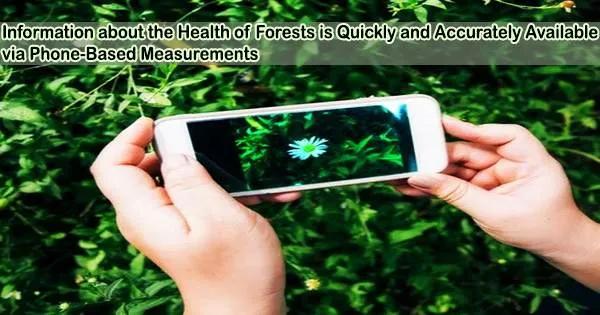Researchers have created an algorithm that reliably measures trees five times faster than manual approaches using computer vision techniques.
The method was created by academics from the University of Cambridge and provides a precise measurement of tree diameter, a crucial indicator used by scientists to track the health of forests and levels of carbon sequestration.
The program produces results that are just as accurate as manual measuring techniques, but significantly faster thanks to the use of low-cost, low-resolution LiDAR sensors found in many smartphones. The results are reported in the journal Remote Sensing.
Tree diameter at chest height is the most common manual measurement in forest ecology. These metrics are used to assess the state of the forest ecosystem as a whole, the health of individual trees, and the amount of carbon being stored.
This procedure takes a lot of time because each tree must be measured separately from the ground, but it is trustworthy. In addition, human error can lead to variations in measurements.
“When you’re trying to figure out how much carbon a forest is sequestering, these ground-based measurements are hugely valuable, but also time-consuming,” said first author Amelia Holcomb from Cambridge’s Department of Computer Science and Technology. “We wanted to know whether we could automate this process.”
Some aspects of forest measurement can be carried out using expensive special-purpose LiDAR sensors, but Holcomb and her colleagues wanted to determine whether these measurements could be taken using cheaper, lower-resolution sensors, of the type that are used in some mobile phones for augmented reality applications.
This type of sensor has been employed in several forest measuring investigations by other researchers, although these studies have been mostly focused on properly managed forests with straight, consistently spaced trees and routine undergrowth clearing. Holcomb and her coworkers sought to see if these sensors could rapidly, automatically, and in a single image provide correct data for non-managed woods.
When you’re trying to figure out how much carbon a forest is sequestering, these ground-based measurements are hugely valuable, but also time-consuming. We wanted to know whether we could automate this process.
Amelia Holcomb
“We wanted to develop an algorithm that could be used in more natural forests, and that could deal with things like low-hanging branches, or trees with natural irregularities,” said Holcomb.
The researchers created an algorithm that, in actual field circumstances, automatically calculates trunk diameter from a single image using a smartphone’s LiDAR sensor. The algorithm was included in a specially created Android smartphone app, and it can produce findings almost instantly.
The researchers carefully measured and photographed trees to create their own dataset before creating the algorithm. They were able to teach the algorithm to distinguish between tree trunks and huge branches, identify the way that trees were leaning, and other details that may help it improve the knowledge about forests using image processing and computer vision techniques.
The researchers tested the app in three different forests one each in the UK, US, and Canada in spring, summer and autumn. The app was able to detect 100% of tree trunks and had a mean error rate of 8%, which is comparable to the error rate when measuring by hand. The process was around four and a half times faster with the app than it was with manual tree-counting, though.
“I was surprised the app works as well as it does,” said Holcomb. “Sometimes I like to challenge it with a particularly crowded bit of forest, or a particularly oddly-shaped tree, and I think there’s no way it will get it right, but it does.”
The researchers claim that their measurement tool might be an accurate, low-cost tool for measuring forests, even in complex forest settings, as it uses sensors that are already built into an increasing number of phones and doesn’t require specialized training.
Later this spring, the researchers hope to release their Android app to the general public.
The research was supported in part by the David Cheriton Graduate Scholarship, the Canadian National Research Council, and the Harding Distinguished Postgraduate Scholarship.





